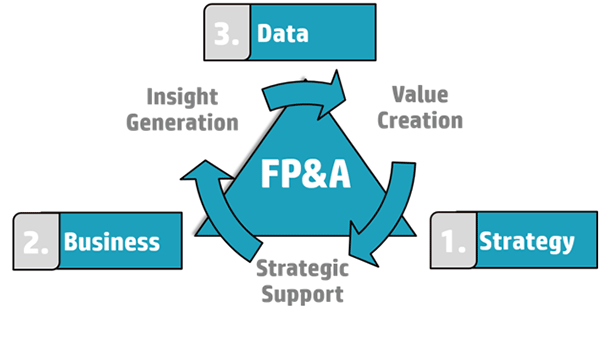 Never before has an FP&A professional had so much opportunity to change the course of history. Uncertainty is becoming the norm and companies are struggling to be nimble or have become too dependent on the past to create the future and find it difficult to adapt to change. While “disruption”, the latest buzz word, we are seeing the more nimble companies winning, but by definition there also have to be losers. How does your company navigate these uncertain times?
Never before has an FP&A professional had so much opportunity to change the course of history. Uncertainty is becoming the norm and companies are struggling to be nimble or have become too dependent on the past to create the future and find it difficult to adapt to change. While “disruption”, the latest buzz word, we are seeing the more nimble companies winning, but by definition there also have to be losers. How does your company navigate these uncertain times?
We view the role in FP&A as a value cycle, giving us the framework to create real value. We offer strategic support to an organization. We are now able to help guide the organization in line with its vision. We lead insight generation and are able to align business to the data and understand what impact it has on the business and finally we create value through insight allowing us to guide the strategy of the business forward. FP&A professionals offer a high value output through strategic support and insight, creating value from data.

Ultimately, the amount of cash a business generates dictates its success, so finance always has a seat on the executive team. Now we are seeing the role expand beyond the traditional back office accounting support function into something more - we are seeing finance teams being closer to the action, empowered to be creative and suggest new ideas.
The great news is that all finance professionals can use “validated learning” 1 to impact business decisions, supporting them with data, then guiding their organization through times of uncertainty. FP&A professionals are becoming the strongest influencers, outside the CEO. The cycle of Strategic Support, Insight Generation and Value Creation drives business direction, turn by turn, towards their ultimate goal
As FP&A professionals, high value output should be our ultimate objective and to really drive the value in an organization we must focus on 3 main areas: Strategy, Business and Data.
The challenge is these are often in addition to all the other requirements in our job description including: Consolidations, Budgeting, Forecasting and Monthly Reporting. Yet, as we accomplish these tasks at hand, we need to also drive forward the value cycle as this is where the real business value lies.
- Strategy – the direction of the company including the long term vision and shorter term missions with tactical goals.
- Business - the partner and customers externally and Sales and Marketing organizations and go-to-market teams internally.
- Data – the data that is held in an organization internally or external data sources. In larger organizations there may be an operations or data analytics group that manage this data, but it can be found in many different departments.
Between Strategy and Business, FP&A’s role is to lead as a strategic partnering. Strategic partnering is taking the agreed strategy and helping the organization translate this into action, ultimately drive business success and shareholder value in line with the vision. Finance teams have always played a role here especially as they have adopted an independent advisory role and a custodian of the company. Remaining independent from the rest of the business can mean that ideas and strategies are fresh but aligned to the vision. In my experience, a key part of decision-making is looking at new proposals from all angles. Finance teams must remain independent to ensure that they have a distinctive perspective.
Between Business and Data – we have insight generation. The role here is working to translate business needs into queries. How often do you get a request from the business to pull a set of numbers together, and this inbound request from the business doesn’t have many details or even make sense. It’s our role to question the request and understand the true need, so we understand the drivers and are better equipped to find the right data to answer the questions. Here I often go through a process of problem diagnosis, customer analysis and data identification. A great tool to help you with this is the “5 Whys” technique - The “5 whys” technique was created by the Toyota Motor Corporation and is an iterative question-asking technique used to explore the cause-and-effect relationships underlying a particular problem.
Finally, value creation, the key learnings that help guide a business through uncertainty - decision are now supported by data. These learnings can ultimately determine the direction of the business, its vision, mission and tactical goals. Value creation often takes the form of a data visualization, but it is the wisdom in knowing that only once we understand what question we are trying to answer and figuring out the right data to answer that question, will you be able to interpret the insight into business direction. Too often I see in FP&A professionals creating reams of reporting without thinking “What question I am trying to answer?” or “What action do I hope the business will take as a result of my interpretation?”.
In the perpetual cycle Value Creation keeps the spin going - Between Big data and Strategy is the sweet spot for FP&A. Now, successful companies take a more analytical approach, moving away from a “Gut Feel” to a “Validated Learning” decision, as Eric Reis calls it. With validated learning, can we influence the direction and strategy of a division, business groups or enterprise? Yes.
The Value Cycle is our approach at redefining FP&A’s role in the organization. To take a leadership position influencing the direction and outcome. It is our role to help facilitate this process by taking the insight that we have generated and converting this into more long term strategic thinking. The place where true wisdom lives.
Subscribe to
FP&A Trends Digest

We will regularly update you on the latest trends and developments in FP&A. Take the opportunity to have articles written by finance thought leaders delivered directly to your inbox; watch compelling webinars; connect with like-minded professionals; and become a part of our global community.

 James Myers is the founder and CEO of FP&A Strategy Consulting, helping to accelerate finance transformation resulting in smarter organizations that focus their talent on issues that matter.
James Myers is the founder and CEO of FP&A Strategy Consulting, helping to accelerate finance transformation resulting in smarter organizations that focus their talent on issues that matter.